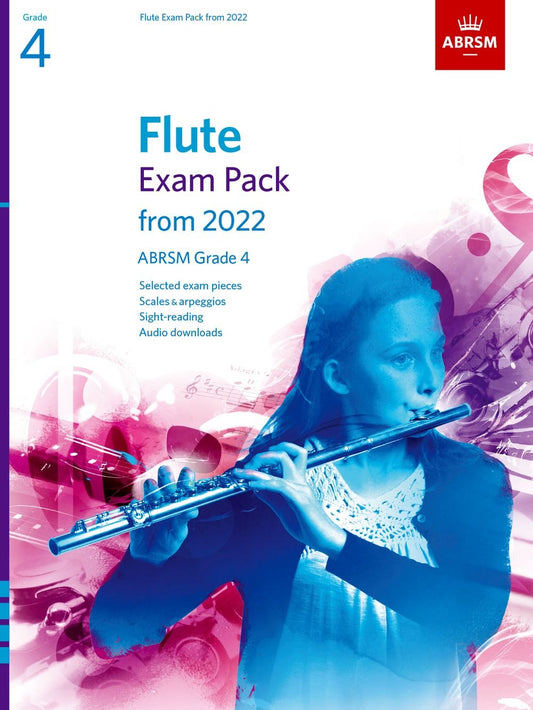-
ABRSM Flute Exam Pack Gr4 22-
Regular price £20.50Regular priceUnit price / per -
Abracadabra Flute - Third Edition
Regular price £9.99Regular priceUnit price / per -
ABRSM Flute Exam Pack 26 Grade 1
Regular price £17.50Regular priceUnit price / per -
Abracadabra Flt Bk+2CD 3rd Ed
Regular price £11.99Regular priceUnit price / per -
TCL Flute Pieces Grade 4 2023- (S+P)
Regular price £18.85Regular priceUnit price / per -
ABRSM Flute Exam Pieces 26 Grade 1
Regular price £15.50Regular priceUnit price / per -
ABRSM Flute Exam Pieces 26 Grade 7
Regular price £21.50Regular priceUnit price / per -
ABRSM Flute Exam Pack 26 Grade 4
Regular price £20.50Regular priceUnit price / per -
ABRSM Flute Exam Pieces 26 Grade 6
Regular price £20.50Regular priceUnit price / per -
ABRSM Flute Exam Pack Gr3 22-
Regular price £19.50Regular priceUnit price / per -
AB Flute Exam Pces Gr3 22-
Regular price £16.50Regular priceUnit price / per -
ABRSM Flute Scales&Arpeggios Gr6-8 Frm2018
Regular price £7.95Regular priceUnit price / per -
New TAD Flute Bk1+CD Ned Bennett
Regular price £14.99Regular priceUnit price / per -
ABRSM Flute Scales&Arpeggios&Sight-Reading Grade 1-5 From 2018
Regular price £12.50Regular priceUnit price / per -
Grade By Grade Flt Gr2 Bk+CD BHP
Regular price £14.99Regular priceUnit price / per -
Faure Morceau de Concours Flt&Pno BOURN
Regular price £4.95Regular priceUnit price / per -
The Irish Flute Book +Online Audio
Regular price £13.99Regular priceUnit price / per -
Bowen Flute Sonata Op120 EME RED
Regular price £16.50Regular priceUnit price / per -
Roll Over Bach Flt&Pno Gorb BW
Regular price £10.25Regular priceUnit price / per -
Rae 42 More Modern Studies Flt UE
Regular price £16.99Regular priceUnit price / per
Collection:
Flute sheet music is a written representation of music specifically arranged for the flute, a woodwind instrument. Its history has evolved alongside the development of music notation and the flute itself, reflecting changes in musical style, flute construction, and performance practices.
Early History
The history of flute music begins with the origins of the flute itself, which dates back thousands of years. The earliest known flutes were made from bone, wood, and other materials and were used by ancient cultures such as the Sumerians, Egyptians, and Greeks. Early musical notation, however, was largely absent, and musicians would pass down songs through oral tradition.
Medieval to Renaissance Period: The medieval and Renaissance flutes were simple, often wooden, end-blown flutes. Musical notation during these periods was somewhat rudimentary. The notation system used for the flute was largely based on the neumatic system (symbols indicating pitch and rhythm) and tablature, a form of notation that indicated finger positions rather than specific pitches.
In the Renaissance, the transverse flute (held sideways) began to take form, and the instrument became more refined. This period saw the development of early flute manuscripts where composers started to write down more structured music for flutes. However, flute music was often part of larger ensembles, with music not always written specifically for the flute.
Baroque Era (1600–1750)
The Baroque period is where we start to see more specific and advanced flute sheet music. The traverso, a wooden flute, became the standard instrument during this time. Flute music became more prominent, with composers like Johann Sebastian Bach, Georg Philipp Telemann, and Carl Philipp Emanuel Bach writing concertos and sonatas specifically for the flute.
Baroque notation typically included figured bass for accompaniment, which was a form of shorthand notation for continuo instruments (such as the harpsichord or cello). This made it easier for performers to improvise or realize the harmonies.
The development of flute fingering systems during the Baroque period also allowed for a greater variety of pitches and nuances in performance, which was reflected in the notation of the music. The Baroque flute had fewer keys, so composers had to work within its limitations.
Classical Period (1750–1830)
The flute underwent further development in the Classical period, with the invention of the Bohemian flute, a wooden instrument with keys. Music became more standardized, and composers such as Wolfgang Amadeus Mozart, Joseph Haydn, and Ludwig van Beethoven began to write concertos, sonatas, and chamber music that featured the flute prominently.
Mozart’s Flute Concerto No. 1 in G Major, for example, is one of the most iconic works in the flute repertoire. During this time, sheet music for the flute started to include more dynamic markings (like piano and forte) and detailed articulation instructions, such as staccato or legato, to provide performers with more expressive freedom.
The keyed flute, which incorporated more keys to extend the instrument’s range, also began to emerge during this period, leading to a broader musical vocabulary for composers to use in their notation.
Romantic Period (1830–1900)
The flute continued to evolve in the Romantic era, with the metal flute becoming more popular. The new design by Theobald Boehm introduced a fully keyed flute system that allowed for a more even tone and greater agility. This led to more virtuosic music and technical demands in flute composition.
Composers like Frédéric Chopin, Richard Strauss, Claude Debussy, and Pyotr Ilyich Tchaikovsky wrote increasingly complex and expressive flute music. The notation during this time became more nuanced, with the inclusion of ornamentation such as trills, turns, and mordents. Composers also began to use more advanced dynamic and articulation markings to reflect the emotional range of the music.
In terms of performance practice, flute music often included more extensive cadenzas (improvised or written-out solos), showcasing the virtuosic abilities of flutists.
20th Century to Present
The 20th century saw an explosion of new styles and techniques in both flute performance and sheet music notation. Composers such as Igor Stravinsky, Olivier Messiaen, Pierre Boulez, and Claude Debussy continued to push the boundaries of the flute, writing music that incorporated new extended techniques such as flutter tonguing, multiphonics, and extended ranges.
The flute also began to feature more prominently in solo repertoire, with many composers writing standalone works for the instrument. The notation system was refined further with precise articulations, complex rhythms, and modern performance practices that included the use of graphic notation and other experimental forms of musical writing.
Flute sheet music also began to be published in a variety of formats, from traditional scores to electronic scores. Today, the flute has an extensive body of work across all genres, and modern flute music notation is highly detailed, incorporating everything from microtonal notation to precise performance instructions.
Key Developments in Flute Notation
- Early Simple Notation: Early music for the flute was written with relatively simple symbols and lacked detail.
- Figured Bass: Used in Baroque music, allowing for improvisation or harmonization by the accompanying musicians.
- Dynamic Markings and Articulations: In the Classical and Romantic periods, more expressive symbols were introduced.
- Advanced Techniques and Extended Notation: In the 20th century, composers began to experiment with new sounds, leading to a more detailed and varied approach to notation.
Conclusion
Flute sheet music has come a long way from its rudimentary early beginnings. As the instrument itself evolved from simple bone flutes to the modern Boehm-system metal flute, so did the complexity and sophistication of the music written for it. Today, flute music encompasses a broad range of styles, from traditional classical works to contemporary avant-garde compositions, all reflected in highly detailed and nuanced sheet music.



















